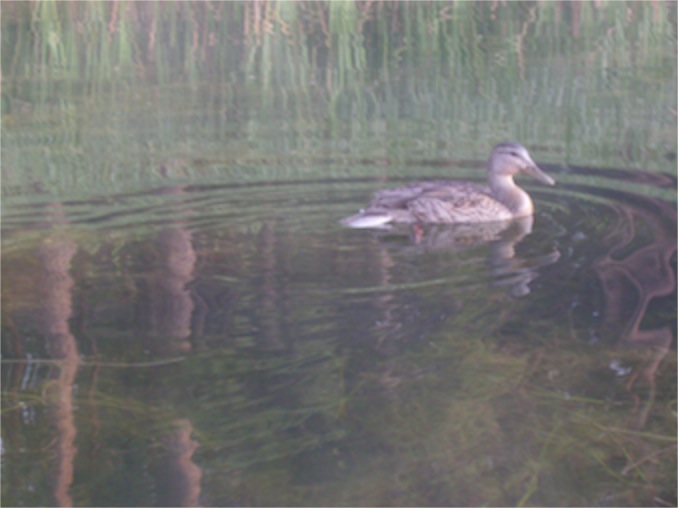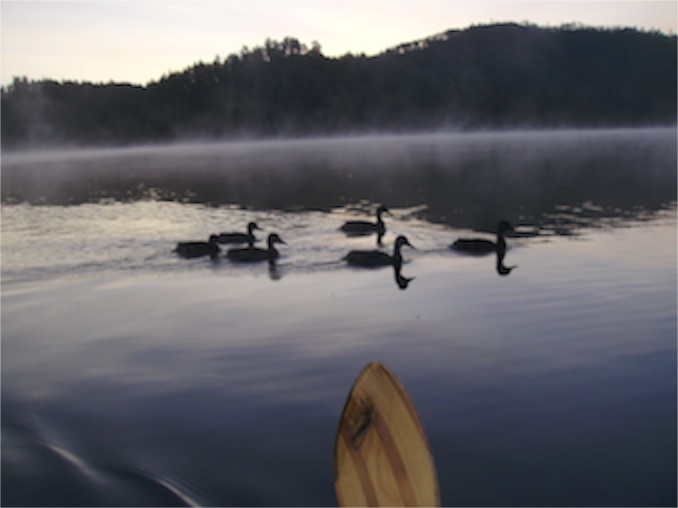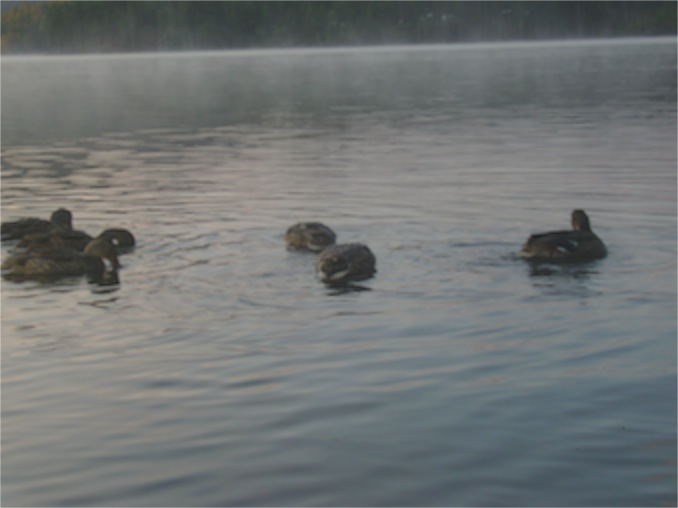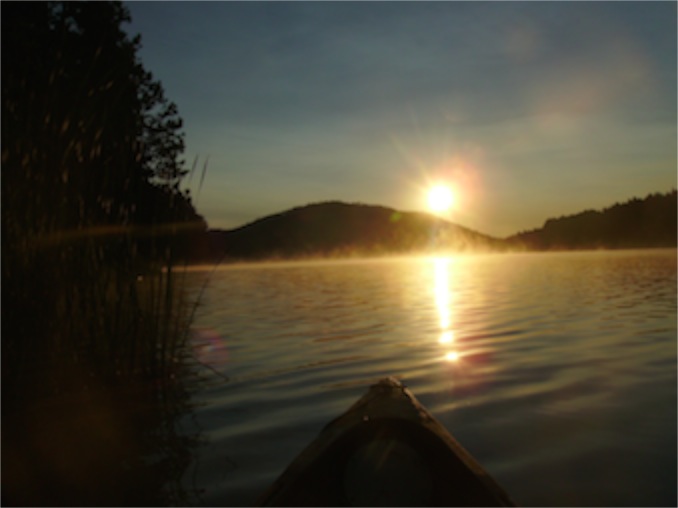Ducks
08/08/13 05:27
It’s an old joke. You’ve probably heard it before, but it goes like this:
 One day a mallard drake was flying over a pond when he spotted a beautiful young hen bobbing on the water below. He flew down and landed next to her. He started talking to her, but she didn’t respond. Just then he heard a rustle in the bushes and yelled, “Duck!” as he dove under the water. A blast from a shotgun followed, but he escaped injury. A minute later, he came to the surface and began to scold the female duck, “You could have been killed! When you hear hunters, you have to duck!” Again he heard the rustle. Again he yelled, “Duck!” Again he dove below the water. And once again he rose to find her bobbing on the surface. Exasperated he scolded her again. He heard the rustle for the third time. He yelled, “Duck!” and dove beneath the surface. This time when he came up there were bits of the female duck scattered around the surface of the water. As he flew away he shrugged his shoulders and said, “Wooden Duck!”
One day a mallard drake was flying over a pond when he spotted a beautiful young hen bobbing on the water below. He flew down and landed next to her. He started talking to her, but she didn’t respond. Just then he heard a rustle in the bushes and yelled, “Duck!” as he dove under the water. A blast from a shotgun followed, but he escaped injury. A minute later, he came to the surface and began to scold the female duck, “You could have been killed! When you hear hunters, you have to duck!” Again he heard the rustle. Again he yelled, “Duck!” Again he dove below the water. And once again he rose to find her bobbing on the surface. Exasperated he scolded her again. He heard the rustle for the third time. He yelled, “Duck!” and dove beneath the surface. This time when he came up there were bits of the female duck scattered around the surface of the water. As he flew away he shrugged his shoulders and said, “Wooden Duck!”
OK it is a silly pun.
I’ve been getting to know a few ducks in my morning paddles. I can’t identify individuals, but I think that I am seeing the same brood each day when I paddle by the cattails along the shore of Sheridan Lake. For the most part, the ducks scatter and swim away from me when I approach in my canoe. But these ducks have become tolerant of my presence and if I approach slowly and quietly and don’t make any sudden moves, they will swim alongside my canoe and allow me to take pictures. Yesterday, they resumed feeding as I sat between them and the shore in my little boat.
 Ducks are amazing birds, really. All water birds have a combination of hydrodynamic and aerodynamic features. Being good swimmers and also good flyers means that they need to have a unique body shape. The feet are situated far enough back on the abdomen to make them a bit ungainly when they walk on the shore, but they are graceful swimmers. The feed by putting their heads under water which at times means that their tails are the only part sticking up into the air as they float. When they aren’t startled they swim easily. It doesn’t seem to take much effort for them to paddle along with their feet and go where they want on the surface of the water. When startled,, they are a bit less graceful, with a bit of splashing as they accelerate. They can take off with a very short run and be flying quickly.
Ducks are amazing birds, really. All water birds have a combination of hydrodynamic and aerodynamic features. Being good swimmers and also good flyers means that they need to have a unique body shape. The feet are situated far enough back on the abdomen to make them a bit ungainly when they walk on the shore, but they are graceful swimmers. The feed by putting their heads under water which at times means that their tails are the only part sticking up into the air as they float. When they aren’t startled they swim easily. It doesn’t seem to take much effort for them to paddle along with their feet and go where they want on the surface of the water. When startled,, they are a bit less graceful, with a bit of splashing as they accelerate. They can take off with a very short run and be flying quickly.
The ducks learn to swim long before they learn to fly and when they are in that phase of life when they can’t fly they are fun to watch on the water. A brood will mostly stay together as they scurry for the cover of the reeds at the edge of the water as my canoe glides by.
 There are lots of dangers for the chicks. On land, there are foxes and bobcats and other mammals that eat baby ducks. In some places there are snakes and turtles that eat baby ducks. Owls and eagles will also occasionally take a baby duck. And there are dangers that come from fast moving water. Small ducklings who are born in river eddies instead of lakes are often washed downstream away from their brood. At the lake I notice a decrease of the number of ducklings in a brood between the first time I spot them and the time they head of in their own directions as grown birds. The mortality rate must be fairly high. That is why they often have more than one brood in a summer. They have to in order to keep the population stable.
There are lots of dangers for the chicks. On land, there are foxes and bobcats and other mammals that eat baby ducks. In some places there are snakes and turtles that eat baby ducks. Owls and eagles will also occasionally take a baby duck. And there are dangers that come from fast moving water. Small ducklings who are born in river eddies instead of lakes are often washed downstream away from their brood. At the lake I notice a decrease of the number of ducklings in a brood between the first time I spot them and the time they head of in their own directions as grown birds. The mortality rate must be fairly high. That is why they often have more than one brood in a summer. They have to in order to keep the population stable.
It may seem that I am blogging about canoeing a lot this summer. My canoe excursions are the subject of most of the pictures I have taken this year. I do spend considerable time at the lake. I try to get in an hour of paddling three or four days each week. I do so in part because the exercise is important for my health and staying healthy and fit gives me endurance for my job. But there is much more to it than the exercise.
The canoe is a vehicle for going to the quiet places and taking time to observe the beauty of this world. It is not just that I enjoy watching the creatures, which I do. It is that I need to remain connected to the natural world in order to stay close to God and have the perspective that is required for the times of intense relationship with people. My life has moments when I am with people who are going through very difficult times. I see my share of distress and discomfort. I try to help people in times of crisis. In order to be fully present for those people, I need to be comfortable in my world and connected to the things that are beyond the crisis and panic of the moment. The lake and its creatures give me a sense of the wider world. The quiet time gives me an opportunity to think and pray and sort out my thoughts and my relationship with God.
 Christine Jerome wrote, “The canoe, that most elegant mode of travel, takes us to places where silence calms the spirit and where perspective returns.” I need silence to calm my spirit and I need the perspective that comes from spending time in the natural world. And I am very fortunate to have a lake so close to my home that I can paddle virtually whenever I want. From the time the ice is out until freeze up all I need is appropriate clothing and a bit of time. Once I finish making a canoe, it requires almost no maintenance and other than a bit of gas for my car to get to and from the lake there are no other costs associated with simply going out and sitting with the world.
Christine Jerome wrote, “The canoe, that most elegant mode of travel, takes us to places where silence calms the spirit and where perspective returns.” I need silence to calm my spirit and I need the perspective that comes from spending time in the natural world. And I am very fortunate to have a lake so close to my home that I can paddle virtually whenever I want. From the time the ice is out until freeze up all I need is appropriate clothing and a bit of time. Once I finish making a canoe, it requires almost no maintenance and other than a bit of gas for my car to get to and from the lake there are no other costs associated with simply going out and sitting with the world.
So I am thankful for the ducks and the lessons they can teach me. They have already taught me to paddle slowly and quietly and to flow with them as they explore their world. These are no decoys. They’re the real deal.

OK it is a silly pun.
I’ve been getting to know a few ducks in my morning paddles. I can’t identify individuals, but I think that I am seeing the same brood each day when I paddle by the cattails along the shore of Sheridan Lake. For the most part, the ducks scatter and swim away from me when I approach in my canoe. But these ducks have become tolerant of my presence and if I approach slowly and quietly and don’t make any sudden moves, they will swim alongside my canoe and allow me to take pictures. Yesterday, they resumed feeding as I sat between them and the shore in my little boat.

The ducks learn to swim long before they learn to fly and when they are in that phase of life when they can’t fly they are fun to watch on the water. A brood will mostly stay together as they scurry for the cover of the reeds at the edge of the water as my canoe glides by.

It may seem that I am blogging about canoeing a lot this summer. My canoe excursions are the subject of most of the pictures I have taken this year. I do spend considerable time at the lake. I try to get in an hour of paddling three or four days each week. I do so in part because the exercise is important for my health and staying healthy and fit gives me endurance for my job. But there is much more to it than the exercise.
The canoe is a vehicle for going to the quiet places and taking time to observe the beauty of this world. It is not just that I enjoy watching the creatures, which I do. It is that I need to remain connected to the natural world in order to stay close to God and have the perspective that is required for the times of intense relationship with people. My life has moments when I am with people who are going through very difficult times. I see my share of distress and discomfort. I try to help people in times of crisis. In order to be fully present for those people, I need to be comfortable in my world and connected to the things that are beyond the crisis and panic of the moment. The lake and its creatures give me a sense of the wider world. The quiet time gives me an opportunity to think and pray and sort out my thoughts and my relationship with God.

So I am thankful for the ducks and the lessons they can teach me. They have already taught me to paddle slowly and quietly and to flow with them as they explore their world. These are no decoys. They’re the real deal.